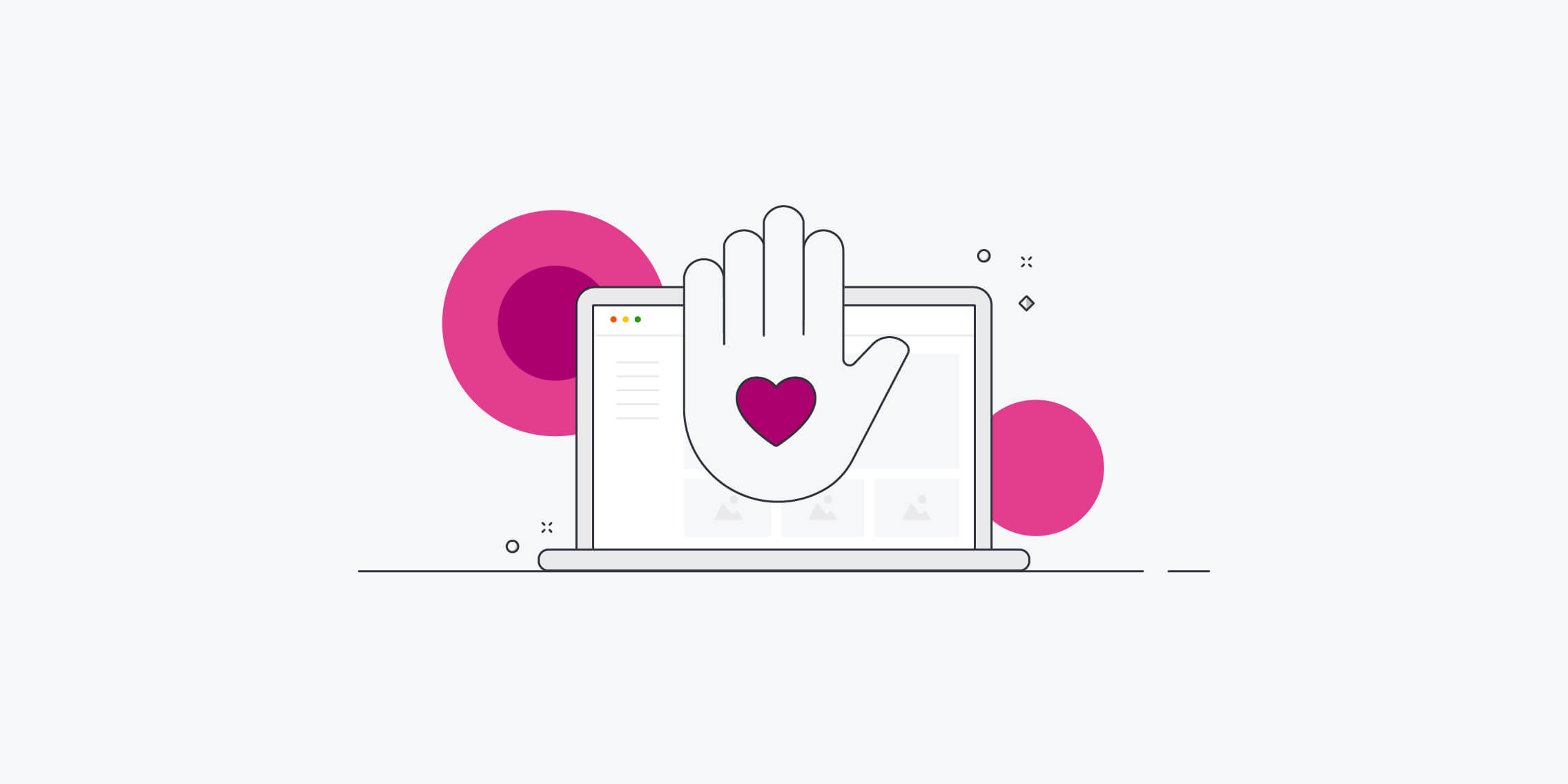Volunteering is a great way to practice your UX skills, build your portfolio, and do some good in the process.
With the rise of remote work, volunteering can take many shapes and forms. So where and how can you find the most suitable opportunities?
In this guide, we will:
Consider this your ultimate resource for UX volunteering. Ready to put your design skills to good use? Let’s go.
Where and how to find UX design volunteer opportunities
In this section, we’ll share all the best resources and methods for finding UX volunteering opportunities.
1. Search volunteering websites
There are countless websites and portals dedicated to matching volunteers with suitable opportunities. It’s usually a simple case of registering as a volunteer and searching for opportunities using certain keywords (e.g. UX/UI design, web design, research) and location criteria.
Here’s our round-up of the best websites for UX volunteering opportunities.
UX and tech-specific volunteering websites
- UX Rescue
- Technology Volunteers
- Benefit Design
- Digital Boost
- SkilledUp Life
- Points of Light
- Digital for Good
Generic volunteering websites
- VolunteerMatch
- Catchafire
- Reach Volunteering
- Taproot Foundation
- Idealist
- JustServe
- CharityJob
- CommuniHelp
Most of these sites offer remote UX opportunities, but it’s worth searching locally, too. Run a Google search for “tech volunteering opportunities” or “UX design volunteer opportunities in [your location]”.
This should bring up both national or regional volunteering portals and specific opportunities in your location.
2. Reach out to non-profit organisations directly
Another way to find UX volunteering opportunities is to contact non-profit organisations directly. This is like a speculative job application.
Start by making a list of causes you care about. Maybe you know of a local charity whose website could do with some UX fixes, or of an upcoming initiative that could use your design skills. If nothing comes to mind, run a search for local charities and go from there. Of course, if you’re looking to volunteer remotely, there’s no need to keep your search local.
Send an email introducing yourself and your reason for reaching out. For example: “I’ve just completed a UX design course and would love to volunteer my skills. I can help with…”
Even if your speculative applications don’t lead to any volunteering work right away, it’s a great way to make a connection. It’s likely that the organisation will keep you in mind for any future UX volunteering opportunities—or put you in touch with someone else who could use your skills.
3. Advertise your services
If you’re active on LinkedIn, why not tell your network that you’re looking for volunteer work? Share a post and set it to “public” for maximum exposure.
Word-of-mouth referrals are extremely powerful, and your post may reach someone who knows someone with a suitable opportunity. The same goes for any other social networks or communities you’re part of. Put the word out there and see what comes up.
Not part of any groups? Here are 12 UX communities that are ready to welcome you.
Now you have some tried-and-tested strategies for finding UX volunteering opportunities, let’s consider why you might want to volunteer in the first place.
5 benefits of volunteering your UX skills
Besides the reward of contributing to a good cause, there are many benefits of volunteering your UX skills.
1. Work on something you’re passionate about
Volunteering means you can use your skills to contribute to something you’re really passionate about. Your project could focus on anything from saving the bees to helping the elderly.
Whatever area you choose, your time will be valued. Design skills could normally be unaffordable for some volunteer groups. It also feels good to try to solve a social problem and make a difference.
Hiring manager James believes that volunteering signals to employers that you have positive outcomes in mind.
2. Add an interesting project to your portfolio
It’s not selfish to think “what’s in it for me?” when it comes to volunteer work either. Volunteering can advance your career by adding interesting projects to your UX portfolio and help you stand out in the hiring process.
UX expert Krys believes in doing one project for free starting out:
“I’m a big believer in getting paid for your work, but it’s ok to do one project for free when you’re building your portfolio. Choose a charity that deserves and needs your help.”
James recommends doing volunteering over unpaid internships: “I’m not in favour of unpaid internships. In my opinion they are predatory on the labour of people who don’t have a lot of power, organisationally. They are also discriminatory against people who can’t afford to live in a city.”
Junior designer Vesna chose to do voluntary groups for the same reason, saying “I know designers who’ve complained about their unpaid internships with corporations. They see that they’re doing the same work as other paid designers. I don’t think it’s fair.”
“Everyone has a different UX journey. Think about what’s the best option for your career path.”
3. Gain real-world experience
Doing UX outside of the learning environment for the first time brings new and exciting challenges. A voluntary project shows that you know how to deal with them.
The UX process isn’t always smooth. Krys explains:
“The real world is very different from your classes. You are taught in school that UX works a certain way, but when you get into the trenches, it’s different. Having that experience on your resume is incredibly valuable and it will help you as a practitioner.”
After studying UX, Vesna wanted to get more real-life collaboration skills. She explained “you won’t learn that from a book, but you need to do it to be able to talk about it in interviews.”
Vesna advises to “just see if you can get that collaboration experience. Even better if it’s something that’s going to be handed over to development. If you can’t find that, work together with some people to experience what it’s like to work on a team.”
Volunteering helped Vesna to confidently talk about growing her UX skills in interviews.
4. Develop in-demand UX skills
Volunteering gives you an opportunity to develop important soft and hard UX skills. Vesna increased her UX knowledge by designing a health app with a group of developers:
“I tried to follow the full UX process. I did interviews, competitive benchmarking, created personas, sketches, wireframes and prototypes. The greatest thing was that my team actually listened! It was actually a great first real-life UX experience.”
It’s important to closely follow the UX process in volunteer projects. Skipping steps can lead to less than ideal outcomes. Don’t feel pressured into doing any “quick UX” by your group. Tell them that you need to follow the UX process to get results.
Volunteering shows hiring managers like James that:
“you got up to speed with the sector, increased your knowledge, made changes to your processes, and collaborated with subject matter experts.”
5. Grow your network
Volunteering presents a great networking opportunity. Depending on the nature of the work, you might connect with both new and senior designers, as well as other tech professionals such as developers, marketers, and product owners.
Networking is an important part of breaking into a new field, so making these connections early on is a good first step.
UX volunteering FAQs (and answers)
Still got questions about volunteering? We’ve enlisted the help of our community experts to answer your UX volunteering FAQs. Here’s who’s on the panel:
Vesna moved from hospitality to UX after studying UX design and building her portfolio through volunteer work. James is a UX mentor with over 10 years experience building and managing UX teams. He also has his own consultancy company. Krys Blackwood has been working in UX for over 20 years. She began her career in Silicon Valley working as both a researcher and designer before moving to NASA where she’s designing the future of mission operations.
Vesna Dean

James O’Brien

Krys Blackwood
Let’s dive in to answer your questions.
1. Is applying for voluntary work like a job interview?
No.
When Vesna applied for voluntary projects, she found that “they were more interested in my help. I’d already set up the portfolio from the UX Design Institute and showed them that. Getting a volunteer position isn’t that hard.”
2. What expectations should I set before starting a project?
It’s wise to be honest about your availability before agreeing to a project.
Everyone has different schedules on voluntary projects. You might be free to dedicate 40 hours per week or 3 hours on weekends. Be open about it.
Your team could also be spread all over the world, so projects can move at a slower pace. You need to be patient with your group.
Confirm how many hours per week you can work and discuss what you can deliver in the timeframe. James believes that this will help keep the commitment manageable. “It’s also a great portfolio case study to show that you understand how to scope the UX process,” he said.
3. I don’t have the time to volunteer. What else can I do?
Not everyone is in the position to volunteer free time. There are other things you can do to build your portfolio.
Do you have transferable skills from previous roles or university studies? Do you have any experience building software? Sell these skills and experiences in your portfolio too.
James encourages job hunters to
“always remember that your portfolio is a sales brochure – make it work hard for you. The UX industry is full of people with unique and interesting pasts who apply that to their daily practice. Don’t be afraid to sell yourself based on your own past!”
We share more tried-and-tested ways to find projects for your UX portfolio here.
In all, volunteering is a great way to practice your UX skills, gain valuable real-world experience, and add an interesting project to your portfolio. If you’re wondering how to build your UX portfolio from scratch, this step-by-step guide has you covered.




